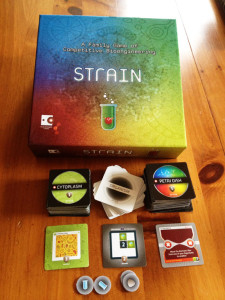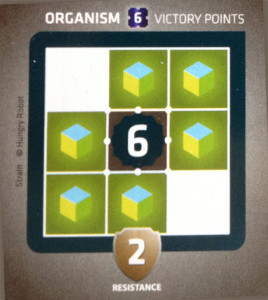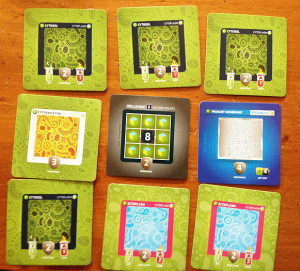
There’s a great little store in the local mall called Marbles – they sell various board games, card games, books, and toys, all to engage the different parts of your mind. It’s a chain, though I don’t think there are too many locations. Anyway, on my first trip there, I saw a tabletop game with an intriguing cover: a test tube bubbling over, amoeba-shaped art floating around it, and a bright, rainbowy color scheme. I asked the shop guy what it was about – he told me, “you basically destroy your opponent with science.” Without even glancing at the reviews on BoardGameGeek, I purchased it. I don’t usually buy a game without any inclination of how it plays, but I knew I needed to have this one. How did I end up liking it? Well, let’s find out.
Overview:
Strain
Publish Date: 2011
Players: 3-7, though there is a two-player variant.
Ages: 10 and up
Length: 60 minutes
BGG Link: Strain
Gameplay/Rules:
The object of Strain is to be the first player to score twelve victory points by completing the objectives pictured on your organism tiles. At the start of the game, the tiles are divided into three piles, differentiated by their categories: cytoplasms, organisms, and petri dishes. On each turn, the player must go through three phases, and perform the optional actions within these phases. The phases are: Awaken, Evolve, and Shed.
Here are the phases in more detail:
1) Awaken Phase: This is where you draw three cards (or tiles, as they are referred to in the rule book) from the three categories mentioned above: cytoplasm, organism, and petri dish. The drawn tiles can be a combination of any of the categories; you can draw two cytoplasms and one organism, or two petri dishes and one cytoplasm, etc.

Organism cards are important, because these are what you will be using to gain your victory points – remember that you need twelve victory points to win! Organism tiles state a different number of required tiles that must be placed around them to score the points indicated. For example, if you pull an organism card with a requirement of seven surrounding tiles, you must have seven tiles around it to score seven victory points. The tiles placed around it must have a building block icon on them to count toward the requirement.

Petri Dish tiles are comprised of three different types of tiles: organelles (which all have a building block icon on them, and do various actions), viruses (which can be used to damage your opponent’s organisms), and actions (which are temporary and change the flow of the game).
Cytoplasm tiles can be placed for free, and also have the building block icon on them. Notice how I said it can be placed for free? Well, in order to place tiles around your organism, you must use ATP – this is the currency of the game. You gain ATP by placing the different tiles around your organism that produce ATP. For example, a cytoplasm tile could produce 3 ATP – this means you now have the ability to place a tile that has an ATP cost of three. Also in the awaken phase, you would turn over any tiles you used in the evolve phase so they can be used again.
2) Evolve Phase: This is the meat of the game. During this phase, you can place your tiles using your ATP (or for free, if they don’t have an ATP cost), or attack your opponent’s organism using your virus cards (which cost ATP to play, and you get that ATP from the cards surrounding your organism). When you attack an opponent, you use action tiles to perform a chain of events. Essentially, you are both flipping action tiles that have different effects – eventually, one of you will be victorious. If you attacked your opponent with a virus card and won the battle, you place a virus card on your opponent’s organism. Organisms cannot be scored if there are viruses on them, so it is imperative that your opponent kills that virus so they can score their victory points. If you lose the battle, your opponent’s organism is safe for that turn.
3) Shed Phase: If you have more than four tiles in your hand, you must discard (hence, “shed”) until you get down to your hand limit. Also, in this phase, you can score any completed organisms. Once it is scored, you return the tiles surrounding it to the discard pile, and keep the organism tile to remind you of your points won.
Players take turns going through these phases, and the first one to score twelve victory points wins the game.
There’s a bit more to this game than what I’ve described, but I just wanted to give the basics. If it seems confusing, that’s because it is. The rule book is not clear, and that was my biggest barrier to enjoying this game. Unfortunately, Strain did not click for me or my gaming partner. We found ourselves unsure of what to do at various moments, especially during the virus battle phase – the rule book wasn’t able to clarify, so we just made up our own rules. Also, this game is not as exciting as it should be; there didn’t seem to be any tension or interesting decisions to make. Battling each other with viruses sounds like a smashing time, but the mechanics of the game lend themselves to slow play. I can see there is potential for a good game here, but the rules and gameplay fall flat. My expectations were high, and I wanted to enjoy this, but was ultimately disappointed. I have since auctioned off the game at BoardGameGeek, and I hope the person that bought it off me will enjoy it more than we did.
Design:

I love the art in this game, so kudos to the designer, Avrom Tobias. It’s cartoonish, but very bright and appealing. The little pictures of viruses, test tubes, characters, and batteries are adorable! The different tiles are color coded, which makes it easier to remember what each one does. There are little bags included for the components – this is always a good thing! There’s nothing like opening a new game with a million chits/meeples/coins, only to find out bags are not included. One awkward thing is the size of the tiles: they’re small, perfectly square, and the weight of regular playing cards. My nurse had trouble shuffling them. While I can see the appeal and reasoning for making them this way (minimizes the amount of table space needed, for example), I wish they were a bit larger. Also, as mentioned above, the rule book is very difficult to understand; information that should appear near the beginning is at the end, and this makes everything so confusing. We had to read the rules a number of times before we were able to get a small enough grasp of the game to begin playing. Even then, we had to continuously look up information online.
Replay Value:
I can see this having some replay value, as you get different combinations of organisms, cytoplasms, and viruses each game. But even though there are multiple combinations, I think this game could get old after a while. That’s just my opinion based on the few games we played, though I hear there are free, downloadable expansions on the designer’s website – so that’s cool.
The Gimp Glimpse:
People who are visually impaired may have trouble seeing the numbers and icons on the cards, as they are fairly small. If you are color blind, this shouldn’t be too much of a problem because of the iconography. For physically disabled folk such as myself, the tiles are very difficult to shuffle and hold in your hand. Even with a card holder, it will be hard to keep them in place while also being able to see their iconography. Also, you will not be able to use a card shuffler (I believe) because of the unique size.
Score:
One and a half stars out of five. I really love the art in this game, but the gameplay and rule book are lacking.
Have you played this game? What did you think? Leave your thoughts in the comment section! Thanks for reading.
